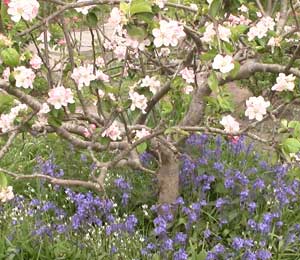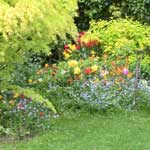1 2 3 4 5 6 7 8 9 10 11 12 13 14 15 16 17 18 19 20 21 22 23 24 25 26 27 28 29 30 31 32 33 34 35 36 37 38 39 40 41 42 43 44 45 46 47 48 49 50 51 52
Gardening diary week 17 beekeeping blog
Diary week seventeen April 23rd - April 29th
This is a good time to start sowing french beeans outside - when the lilac is in bloom - both the dwarf and the climbing varieties.
2017
Monday 24th April. The weather is changeing. We had a little rain today - but not much. I'm still watering my carrots, shallots and lutuce. Next the forecast is for a cold spell. It was already too cold today for the honeybees to be out - but the bumble bees are made of sterner stuff - see video
2008
Sunday 27th April 2008 I normally sow peas directly into the ground but for some reason this year I have germinated quite a few in pots and then planted them out. There are some advantages in growing peas this way. You don't get any gaps in the row where seeds have been eaten by birds or rodents and you have an extra couple of weeks whilst the peas germinate in the pots in order to dig muck into the ground and prepare the bed. I takes longer to plant them out than to sow seed but the resulting straight row of peas evenly spaced apart is very satisfying. Now we need a really good rain to get them growing well.
Saturday 26th April 2008 What a contrast. Just one week ago today it was
warm and pretty much sunny all day. The the first of
the apple blossom is out and the asparagus is begining
to force it's way up through the ground.
The purple sprouting
broccoli will soon be over as far as picking and eating
is concerned and will be flowering soon, although there
was still some to pick.
One of my obsessions is self
seeding vegetables. My allotment now has a small list
of plants that seed themselves. Most reliable is the
everlasting or beet spinach that grows every year in
a variety of forms and colour. The parsnips seed themselves
all over the plot and rocket, land cress and parsley do in several areas now. My
sprouting broccoli that pops up in almost any bit of land cultivated at
this time of the year is a mixture of several selected varieties of purple
sprouting broccoli and white sprouting broccoli often with some other cabbage
or sprout genes added in. The result is a wide variety of plants that grow and
crop at a different times. I will let many plants flower, as the bees like
them, and leave one to go to seed. Some I have already been chopped
up and dug into the ground under the runner bean and some are in the compost
bin.
The first of the beans sown in pots where planted out this week and for the first time in many years I bought a new packet of runner bean seed from the allotment shed.
I am digging around under the peach tree it's the first time I have dug up to and around the base of the trunk of the tree. It is quite a large tree now and this year has no more verbaskum growing under it they have been replaced by the yellow rooted stinging nettle that has become so well established it will take me some time to get it all out.
Pricked out the aubergines seedlings into pots.
2007 This April must have been one
of the driest on record and with hardly a drop falling
from the sky it was necessary to have the hose connected
for most of the month. The sun shone as if it was summer
and the bonus for us was the pollination of all of
our fruit trees including the pears and the peaches.
2006 Thursday 27th April 2006 The greengage tree outside my
window has been flowering for some days now and is being constantly visited by
a variety of bees. There is every indication that we should get a reasonable
plum crop this year although I think the overall number of honey bees must be
low this as the cold weather during the long winter has taken it's toll on the
number of colonies that have survived.
Sold first nuc of the year today.
Wednesday 26th April 2006 Planted potatoes
Tuesday 25th April weeded onions on Geoff's plot. Gave garlic compost and put
bin back together. Potted on cabbages
Tuesday 24th April Opened up compost near the bee hives in Geoff's allotment
and prepared site for climbing French beans with it. Geoff is going to put up
the posts this year as he likes them sited precisely.
Saturday 23rd planted a new row of asparagus
Sunk pots with germinated snowdrop seedlings in under the other large apple tree.
Will cover tops of pots with leaf mould when the plants have died down and leave
them until next year.
2005 Tuesday 26th April 2005 I put a feeder on the the hive
with the new swarm in it. The long promised rain has arrived - well what is left
of it - most of it has fallen on Britain to the west of us.
Monday 25th April 2005 We have had a run of warm sunny days now and I was called
out to pick up the first swarm of the year.
Sunday 24th April 2005 I removed a queen from one of the hives and put it in
a new brood box with a few bees and a couple of frames of honey to put on the
students allotment.
2004 29th We have had a considerable amount of rain in the last
few days as was evident by a wheel barrow half full of water in the apiary allotment.
I spent some time this evening sorting out and transplanting my bluebells. I
have several sorts of bluebells (click for an explanation) the English wild bluebell
that has the flower bells down one side of the stem, the Spanish bluebell that
has flowers all around the stem and hybrids of the two have a random arrangement.
So I am separating the original English bluebell from the others and growing
them apart in an attempt to prevent them interbreeding. They are sharing a space
under an apple tree with the Star of Bethlehem (Ornithogalum umbellatum) that
I have been growing for many years now and have built up quite a stock of bulbs.
They disappear after flowering and have a habit of cropping up somewhere else
in subsequent years as the smaller bulbs can get dug up and re-planted without
being noticed.
If you are interested in bluebells Bluebells for Britain have an online survey
that they would like your help with
April 24/25 Sowed first French beans and planted out red onion seedlings grown
by John. Split up one of the bee hives in the other allotment apiary.
April 23rd 2004 The queen is dead - long live the queen.
I hate doing it - killing a queen bee. Especially when she has given her best
in several years good service and in her turn been the mother of other good queens.
But it has to be done. When a queen bee gets old and starts to run out of eggs
the worker bees will make a queen cell for her to lay an egg in where they will
feed the hatching grub with royal jelly and as a result produce a new young queen.
All of which is fine except that having two queens in a beehive is rarely successful
and one of the two has to go and the old queen is likely to swarm. In order to
prevent this event the old queen has to be removed from the hive.
As I removed the queen before she had dropped an egg in her selected cell several
other cells are likely to be made into queen cells. In a weeks time I will open
the hive again and select the best looking completed cell and remove the others.
I won't then open the hive again for a month by which time the new young queen will have hatched, left the hive for a maiden flight, mated, returned to the hive and started laying eggs - that's
if all goes to plan.
2003 25th April Rain at last. Used up a complete bag of blood
fish and bone feeding potatoes, onions shallots and garlic.
2002 Sunday 28th 2002 We had substantial rain during the night
and early morning that added to that of the day before and has now made a real
difference to the allotment. When I sowed the last French beans just a few days
ago it was like sowing them into sand it was so dry and dusty. Now the soil is
in perfect condition for planting out cabbages and lettuces and for sowing more
seed. The day was bright with patches of warm sunshine and scudding clouds brought
over with a strong wind from the west. The showers held off until evening allowing
time to finish planting potatoes and planting out. As the wind was blowing I
weeded the carrots (sown some weeks ago) for the first time, trying all the time
not to touch the carrots themselves that were now showing their true 'carrot'
leaves. With a bit of luck they will not need too much more weeding and will
be able to compete with any new weeds that will germinate now as a result of
the rain and the newly disturbed soil. Before leaving the plot and the arrival
of more rain I gave the onion sets and shallots a generous dressing of blood
fish and bone hoping that it will get well watered in. The onions sets will need
weeding in the next few days.
April 27th 2002 Saturday afternoon was more typical for the time of year - April
showers have arrived. Although there were two heavy downpours (one of hailstones)
they were very short and didn't stop the action for long. Sowed more radishes
(Sparkler2) a row of beetroot (Boltaroy) a row of carrots (Berlicum2) and more
potatoes (Pink Fir Apple) Dug more ground.
April 26th 2002 Finally the rain arrived today. After a month or more of dry
weather (so much for April showers!) and very warm sunny weather in the last
couple of weeks, the wind has turned to the north east, the temperature dropped
and the rain arrived. The sprouts put in yesterday looked fine and the rain had
stopped by early evening in time to plant out some calabrese. I'm glad I weeded
the Japanese onions and the shallots yesterday I also gave them some of the first
home made (stinging nettle) liquid feed. The spring cabbage have been big enough
to cut for the last week or so, but are only now a really good size. The asparagus
has begun to emerge from it's leaf mould mulch and the first radishes were also
ready to pick.
April 25th 2002 Planted out first rows of sprouts.
2000 21/22/23/24/ After a third week of cold winds from the
North there has been a change in direction with strong winds from the west -
much warmer and wet. The bees in the allotment are now a strong colony and raring
to go. The have begun to use the new supper but the weather has prevented them
making much headway. The stores in the brood box have now been almost completely
used and replaced with brood. I'm sure the full supper has also provided a useful
supply of food in these cold weeks even if it has been replaced as soon as the
sun shines. This hive swarmed last year and has a young unmarked and unclipped
queen in residence and despite the extra space of a new supper I have had to
remove queen cups on the last two inspections. I think vigilance will be the
order of the day here if I'm to avoid another swarm this year.
My modest town garden doesn't have much work to do in it at this time of year.
Mowing the lawn and a little pruning of the Forsythia that has now finished flowering.
My weed tolerant regime gives me a display of dandelion honesty and forget-me-not's
mixed with the planted wallflowers and tulips - a riot of colour. If I had the
space I would experiment with just a combination of dandelion and purple honesty
that are such a contrast to each other. Who ever follows me will probably curse
my dandelion tolerance and take years to remove them all but they don't flower
for long and can be dug out after flowering to make space for more choice summer
specimens. The allotment now has several rows of potatoes planted, shallots,
garlic, broad beans, carrots, beetroot, onion sets, spinach, and a row of various
brassica seeds sown (Cauliflower - All The Year Round and English Winter, Cabbage
- Savoy, Christmas Drumhead, January King, Holland Late Winter, Broccoli - Purple
and White). The cold weather in the last few weeks has extended the cropping
season for the purple and white sprouting broccoli but as the weather warms that
will soon change and the plants will run to flower and need to be pulled up and
put on to the compost heap or dug in under the last of the main crop potato planting.
1999 April 24th/25th. A beautiful sunny weekend. The Lilac is
in bloom - time to begin sowing French beans - but not too many as there is still
a chance of loosing these early sowings to a late hard frost - they can be sown
weekly until well into July if both main crop and late varieties are chosen.
I sow some late varieties now in order to have plenty of seed for next year's
late sowings as those sown in July are less likely to set seed easily.
Moved many plants around. Hoed, sowed seeds weeded the onions, garlic and shallots
by hand. I've sown more broad beans - possibly the last for this year as I find
late sowings of broad beans less than a 100% successful and not really required
in the Autumn when there are plenty of other vegetables to hand.
April 26th
The weather this evening has made a sudden change. It's much cooler than yesterday
the wind has turned Easterly and there is a fine drizzle casting a cool blanket
over everything - ideal for planting out cabbages, lettuces and garden plants
that need relocating to a new site and of course digging and planting more potatoes.
Sowed more lettuce, radish, cauliflower.






